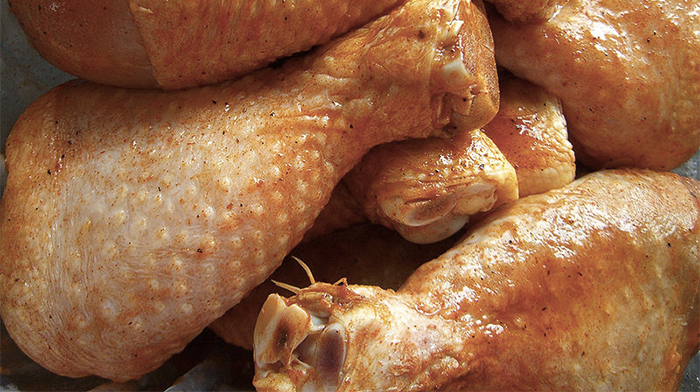
73% of fresh chickens on sale in supermarkets in the UK are contaminated with the food poisoning bug campylobacter, according to the latest tests by the Food Standards Agency.
Campylobacter is a food bug mainly found on raw poultry and is the biggest cause of food poisoning in the UK.
19% of chickens tested positive for campylobacter within the highest band of contamination.
7% of packaging tested positive for the presence of campylobacter. Only three out of more than 3,000 samples of packaging tested positive at the highest band of contamination.
This 12-month survey, which ran from February 2014 to now, tested 4,000 samples of whole chickens bought from UK retail outlets and smaller independent stores and butchers.
The results show, taking the confidence intervals into account, that Tesco is the only one of the main retailers which has a lower incidence of chicken contaminated with campylobacter at the highest level (>1,000 cfu/g), compared to the industry average.
Asda is the only main retailer which has a higher incidence of chicken that is contaminated by campylobacter at the highest level, compared to the industry average. However, the results suggest that none of the retailers is achieving the joint industry target for reducing campylobacter.
Steve Wearne, FSA Director of Policy, said: "We now know it is possible to make positive inroads in the reduction of campylobacter. Figures released today by M&S show that their intervention plan has resulted in fewer contaminated chickens on sale in their stores. If one retailer can achieve this campylobacter reduction through systematic interventions then others can, and should.
"Our survey is putting pressure on retailers to work with poultry processors to do more to tackle campylobacter. We want the industry to reduce the number of the most highly contaminated chickens as we know this will have the greatest impact on public health.
"Campylobacter is killed by thorough cooking, but it should not be left to consumers to manage the risk. It is the most common form of food poisoning in the UK, affecting an estimated 280,000 people a year. Poultry is the source of the majority of these cases, so the industry should be making every effort to ensure chickens are as free from campylobacter as possible before they reach customers.
Richard McDonald, Chair of the ACT (Acting on Campylobacter Together) Board, said: "The UK is leading the way in the search for solutions to reduce campylobacter levels. We have learned a lot over the last five years about which interventions have the potential to make chicken safer. We must continue to work together to apply these successfully and help industry deliver the results we all want to see.
"The ACT Board is central to this work and represents a forum where processors and retailers can come together to discuss their work to tackle campylobacter and results from the latest interventions. This collaborative approach will be essential as the focus shifts to application and delivery.
"Although the impact of industry interventions has not been seen in the results from the FSA survey to date, we look forward to seeing progress in the FSA’s follow up survey."
Executive Director at Which? Richard Lloyd, said: "It’s unacceptable that we're still seeing such high and rising levels of campylobacter in chicken. While four major supermarkets have made their action plans public, the remaining three have yet to say how they're planning to tackle this bug. People need reassurance that supermarkets are doing everything they can to make chicken safe. The remaining retailers must publish their plans and commit to action now before consumer's lose confidence in them."
Marks & Spencer and its supplier, 2 Sisters Food Group, have developed a five-point plan, an integrated programme of interventions along the food chain to reduce levels of campylobacter.
Asda and its supplier, Faccenda, have committed to an innovative new steam technology (SonoSteam) that has shown promising results in tests and is now being installed at the Faccenda factory for full scale, in line trials.
Moy Park’s development of on-farm biosecurity, which has found cost effective ways of exceeding Red Tractor standards.
A number of retailers have introduced ‘roast in the bag’ chickens which help limit cross-contamination by minimising the handling of the raw chicken in the home.
It is likely that recent interventions to reduce the levels of campylobacter will not be reflected in the survey results at this stage. The results from on-going sampling will allow the FSA and the food industry to see what impact they have had.
The FSA advised that the data for individual retailers have to be interpreted carefully. Confidence intervals are given for each retailer and the ‘others’ category. These show the likely range of the results allowing for the number of samples taken.
